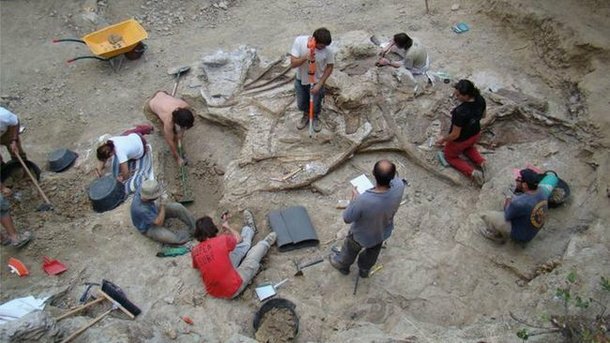
An impressive paleontological find in Spain has revealed the existence of a giant, primitive long-necked sauropod that lived approximately 122 million years ago.
This dinosaur, never before documented by science, shocked the scientific community, which believes it could offer valuable insights into the evolution of sauropods.
see more
New nail trends: there’s something for all tastes
Archaeologists find horse skeleton with AMAZING detail in…

Source: GBE-UNED/Disclosure
Named Garumbatitan morellensis, the newly discovered “titan” was found during excavations in archaeological site of Sant Antoni de la Vespa, near the city of Morella, between 2005 and 2008.
Researchers have identified the remains of at least three individuals of this species, including colossal vertebrae, long leg bones and two almost complete sets of foot bones.
A detailed study, published in the journal Zoological Journal of the Linnean Society on September 28, describes sauropods as quadrupedal herbivorous dinosaurs, characterized by their elongated necks and tails, often reaching immeasurable sizes.
The G. morellensis, in turn, appears to belong to a subgroup called titanosaurs, which were more massive and the only lineage of sauropods that survived until the mass extinction, around 66 million years ago of years.
Based on the bones available for analysis, researchers were unable to accurately determine the exact size of these creatures.
However, one of the individuals stood out for its size, displaying vertebrae more than one meter wide and a femur almost two meters long.

Source: GBE-UNED/Disclosure
These findings suggest that these dinosaurs probably had at least an average height typical of titanosaurs, around 28 meters.
On average, the heaviest titanosaurs weighed approximately 70 tons. Although they were heaviest, they weren't the longest, which makes the new species' elongated neck all the more surprising.
Additionally, the shape of the bones in G. morellensis suggests that it was one of the most primitive sauropods in the Somphospondyli subgroup.
Until now, fossils of this type have been found on all modern continents, but their origin was unknown, remaining one of the greatest mysteries of the world. evolutionary process.
The discovery in Spain raises the hypothesis that Europe may have been the birthplace of titanosaurs before their global dispersal, although more evidence is needed to confirm this theory.
The research team believes that Sant Antoni de la Vespa and other sites on the Iberian Peninsula could be key to unraveling the evolution of sauropods.
In 2022, scientists also revealed the remains of a huge unidentified sauropod in Portugal, which was a contender for the title of largest known dinosaur fossil from Europe, dating back around 150 million years back.


